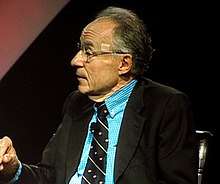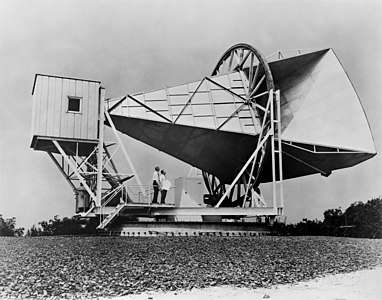Arno Allan Penzias
Arno Allan Penzias (/ˈpɛnziəs/; born April 26, 1933) is an American physicist, radio astronomer and Nobel laureate in physics. Along with Robert Woodrow Wilson, he discoverered the cosmic microwave background radiation, which helped establish the Big Bang theory of cosmology.
Arno Allan Penzias | |
|---|---|
 | |
| Born | April 26, 1933 |
| Nationality | United States |
| Alma mater | City College of New York Columbia University |
| Known for | Cosmic Microwave Background Radiation |
| Spouse(s) | Sherry Penzias |
| Awards | Henry Draper Medal (1977) Nobel Prize in Physics (1978) Harold Pender Award (1991) IRI Medal (1998) |
| Scientific career | |
| Fields | Physics |
| Institutions | Bell Labs |
| Part of a series on | ||||
| Physical cosmology | ||||
|---|---|---|---|---|
 | ||||
|
Early universe
|
||||
|
Expansion · Future |
||||
|
Components · Structure
|
||||
| ||||
Early life and education
Penzias was born in Munich, Germany, the son of Justine (née Eisenreich) and Karl Penzias, who ran a leather business.[1][2] His grandparents had come to Munich from Poland and were among the leaders of the Reichenbach Strasse Shul. At age six, he and his brother Gunther were among the Jewish children evacuated to Britain as part of the Kindertransport rescue operation. Some time later,[3] his parents also fled Nazi Germany for the U.S., and the family settled in the Garment District of New York City in 1940. In 1946, Penzias became a naturalized citizen of the United States. He graduated from Brooklyn Technical High School in 1951[4] and after enrolling to study chemistry at the City College of New York, he changed majors and graduated 1954 with a degree in physics, ranked near the top of his class.
Following graduation, Penzias served for two years as a radar officer in the U.S. Army Signal Corps. This led to a research assistantship in the Columbia University Radiation Laboratory, which was then heavily involved in microwave physics. Penzias worked under Charles Townes, who later invented the maser.
Next, Penzias enrolled as a graduate student at Columbia in 1956. He earned a Ph.D. in physics from Columbia University in 1962.[5]
Career
Penzias went on to work at Bell Labs in Holmdel, New Jersey, where, with Robert Woodrow Wilson, he worked on ultra-sensitive cryogenic microwave receivers, intended for radio astronomy observations. In 1964, on building their most sensitive antenna/receiver system, the pair encountered radio noise which they could not explain.[6] It was far less energetic than the radiation given off by the Milky Way, and it was isotropic, so they assumed their instrument was subject to interference by terrestrial sources. They tried, and then rejected, the hypothesis that the radio noise emanated from New York City. An examination of the microwave horn antenna showed it was full of bat and pigeon droppings (which Penzias described as "white dielectric material"). After the pair removed the dung buildup the noise remained. Having rejected all sources of interference, Penzias contacted Robert Dicke, who suggested it might be the background radiation predicted by some cosmological theories. The pair agreed with Dicke to publish side-by-side letters in the Astrophysical Journal, with Penzias and Wilson describing their observations[7] and Dicke suggesting the interpretation as the cosmic microwave background radiation (CMB), the radio remnant of the Big Bang.[3][8] This allowed astronomers to confirm the Big Bang, and to correct many of their previous assumptions about it.

He was elected a Fellow of the American Academy of Arts and Sciences and the National Academy of Sciences in 1975.[9][10] Penzias and Wilson received the 1978 Nobel Prize, sharing it with Pyotr Leonidovich Kapitsa (Kapitsa's work on Low-temperature physics was unrelated to Penzias and Wilson's). In 1977, the two had received the Henry Draper Medal of the National Academy of Sciences.[11] In 1979, Penzias received the Golden Plate Award of the American Academy of Achievement.[12] He is also the recipient of The International Center in New York's Award of Excellence. In 1998, he was awarded the IRI Medal from the Industrial Research Institute.
On April 26, 2019 the Nürnberger Astronomische Gesellschaft e.V. (NAG) inaugurated the 3-m radio telescope at the Regiomontanus-Sternwarte, the public observatory of Nuremberg, and dedicated this instrument to Arno Penzias. Acknowledging the outstanding scientific merits and the personal history of Arno Penzias as well as the importance of the accessibility to science for all citizens the Minister-President of Bavaria, Dr. Markus Söder participated in this celebration.
Penzias has been a resident of Highland Park, New Jersey.[13] He has a son, David, and two daughters, Mindy Penzias Dirks, PhD, and Rabbi Shifra (Laurie) Weiss-Penzias.[14][15] He currently serves as a venture partner at New Enterprise Associates.[16]
Works
- Wilson, R. W.; Penzias, A. A. (1967). "Isotropy of Cosmic Background Radiation at 4080 Megahertz". Science. 156 (3778): 1100–1101. Bibcode:1967Sci...156.1100W. doi:10.1126/science.156.3778.1100. PMID 17774056.
- Penzias, A. A.; Wilson, R. W. (1970). "Microwave Noise from Rainstorms". Science. 169 (3945): 583–584. Bibcode:1970Sci...169..583P. doi:10.1126/science.169.3945.583. PMID 17746031.
- Penzias, Arno A. (1979). "The Origin of the Elements". Science. 205 (4406): 549–554. Bibcode:1979Sci...205..549P. doi:10.1126/science.205.4406.549. PMID 17729659.
- Penzias, Arno A. (1980). "Nuclear Processing and Isotopes in the Galaxy". Science. 208 (4445): 663–669. Bibcode:1980Sci...208..663P. doi:10.1126/science.208.4445.663. PMID 17771085.
- Cite Video | BBC/WGBH BOSTON | NOVA #519 | A Whisper From Space | Copyright 1978 | Available With Permission | Consolidated Aircraft - Ronkonkoma, New York
See also
| Wikimedia Commons has media related to Arno Penzias. |
References
- Notable Twentieth-century Scientists: L-R
- "Arno Allan Penzias". HowStuffWorks. July 2010. Retrieved 26 November 2013.
- Arno Allan Penzias on Nobelprize.org including the Nobel Lecture, December 8, 1978 The Origin of Elements
- "BTHS.com". Brooklyn Technical High School. Retrieved 18 March 2014.
- "Arno Allan Penzias". IEEE Global History Network. IEEE. Retrieved 10 August 2011.
- www.physics.org. "Nobel-prize winning accidents". Archived from the original on 3 December 2013. Retrieved 24 April 2012.
- Penzias, A.A.; Wilson, R.W. (1965). "A Measurement of Excess Antenna Temperature at 4080 Mc/s". Astrophysical Journal. 142: 419–421. Bibcode:1965ApJ...142..419P. doi:10.1086/148307.
- Lehrer, Jonah (21 December 2009). "The Neuroscience of Screwing up". Wired. Archived from the original on 29 December 2009. Retrieved 21 December 2009.
- "Book of Members, 1780-2010: Chapter P" (PDF). American Academy of Arts and Sciences. Archived (PDF) from the original on 15 May 2011. Retrieved 7 April 2011.
- "Arno Penzias".
- "Henry Draper Medal". National Academy of Sciences. Archived from the original on 26 January 2013. Retrieved 24 February 2011.
- "Golden Plate Awardees of the American Academy of Achievement". www.achievement.org. American Academy of Achievement.
- Horner, Shirley (3 October 1993). "About Books". The New York Times. Retrieved 23 October 2009.
- B Schlessinger, Bernard S. and June H., Who's Who of Nobel Prize Winners, 1901-1990, (Oryx Press, 1991) p. 203
- Rabbi Jonathan Klein's Blog, Sept. 22, 2006
- Team / Arno Penzias
External links
| Wikiquote has quotations related to: Arno Allan Penzias |
- Arno Allan Penzias on Nobelprize.org including the Nobel Lecture, December 8, 1978 The Origin of Elements
- The first part of an article authored by Arno Penzias that was published in Science Reporter magazine
- The second part of an article authored by Arno Penzias entitled Ideas
- A Whisper From Space (IMDb)
- Nürnberger Astronomische Gesellschaft e.V.: Web-Seite Arno-Penzias-Radioteleskop (german)